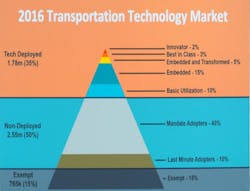NASHVILLE, TN. Mandated electronic logging devices, or ELDs, for commercial truck drivers are just around the corner. As the trucking industry approaches a watershed moment of technology adoption because of that, it may drive more than you think — don't let your competitors outpace you, PeopleNet advises.
"I'd like to show you the transportation industry through a lens that maybe you've never seen before," said Mark Kessler, general manager of trucking for the company, at PeopleNet's and fellow Trimble firm TMW Systems' first combined in.sight conference.
He noted that fleets and trucking companies will be rolling out ELDs next year, with the mandate taking effect in December 2017, and more than 4.3 million trucks will have these devices installed. "Currently, 1.8 million have some technology onboard. Another 800,000 trucks have some kind of exemption status" and won't need to use ELDs, Kessler said.
"So think about that: over the past 15 years, we've had 1.8 million [trucks with technology deployed]; in the next 15 months, we've got another 2.5 million that are being mandated.
"This is going to be the biggest data explosion we've ever seen in transportation history," he contended.
All those trucks that don't have this level of technology now will cause a sort of "data collision" and could help drive "innovations like we've never seen," Kessler added, and along with this coming data and technology explosion in trucks could come "new ways to move freight from point A to point B we've never dreamed of."
Kessler showed the audience of in.sight attendees a pyramid illustrating the various levels of tech deployment in trucks today. Within the 2.5 million trucks that are now "non-tech-deployed" are last-minute e-driver log adopters accounting for about 10% of the market at large.
"These are the groups that have been publicized — about 30% of small fleets and owner-operators — that are saying, 'You know what? We're going to wait till after the mandate comes, and then we'll decide if we'll adopt ELDs onboard our trucks,'" Kessler said. "They're going to see what the ramifications are."
And then there are a group of "mandate adopters." PeopleNet reckons this group, which accounts for some 2 million commercial trucks, don't have technology deployed yet, but will by the time the ELD mandate takes effect. This group is shopping around and considering options that will bring its trucks into compliance.
But here's the key: "We've broken them down into two specific groups. About 80% of them are thinking, 'I just want a solution that's going to get me compliant,'" Kessler said. The remaining 20%, however, make up the group PeopleNet finds "most compelling" in that it could be first in driving a very significant change in the industry.
"The other 20% of that group is saying, 'You know what? I've got to spend money on this technology; I'm going to really integrate it in my back office. I want to get my ROI and efficiency out of it," he contended. "And I think that over time, that 'just to be compliant' group will actually migrate toward more of an enterprise-wide solution. The competitive advantage you've had for half a decade or maybe even a decade is eroding overnight."
There are more elements to the present technology pyramid. The next-higher group represents some 25% of the marketplace and has basic technology deployment, perhaps including a back-office management system and value-added services beyond some truck-based tech. Above that group are fleets and trucking companies with technology embedded in some aspect of operations like fuel economy monitoring/ optimization or reducing out-of-route miles — but they don't have buy-in across the organization, including leadership.
PeopleNet divvies up the top of the pyramid into a further three categories: (1) those who've embedded technology in operations and have organization-wide buy-in; (2) a "best-in-class" group with top safety metrics, safety ratings, and efficiencies that's been getting high ROI from technology for several years or more; and finally, (3) the topmost elite — "the innovators" that have embedded technology so thoroughly and effectively that they're achieving "a compelling competitive advantage," said Kessler.
He urged fleets to consider the pyramid and give themselves an honest assessment, suggesting that many are actually below where they think compared to competitors.
"We have the advantage of going into thousands of fleets a year and seeing what everybody does — how they install technology and embed it in their operations. You're going to the same four walls every day," he quipped.
"Now more than ever, this mandate is causing all these non-tech-deployed trucks to catch up with you. So now more than ever, it's important to innovate," Kessler contended. "Think about how you can get north in this pyramid."
About the Author
Aaron Marsh
Aaron Marsh is a former senior editor of FleetOwner, who wrote for the publication from 2015 to 2019.

